
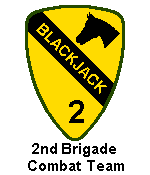
2nd Brigade Combat Team
1st Cavalry Division
Organizational Legacy
"Blackjack"


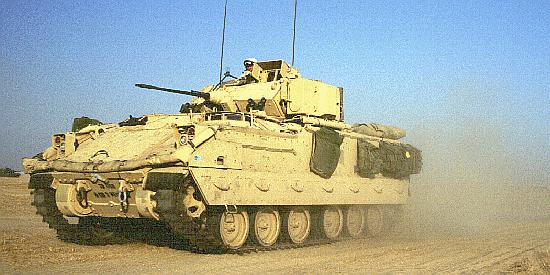 |
|---|
| Bradley M-2/2A Fighting Vehicle Deployed in the Gulf |
|---|

Command Distinctive Unit Insignia
 Introduction
Introduction


 The 1st Cavalry Division, a major subordinate command of the US Third Mobile
Armored Corps, is a 19,000 soldier, heavy armored division stationed at Ft.
Hood, TX. As one of the two "on-call" heavy contingency force divisions of the
Army, the First Team has an on-order mission to deploy by sea, air or land to
any part of the world on a short notice. The following narratives, divided in
timeline eras of major operational missions, describes the threat environment,
tactical conditions, evolution of equipment technology and the strategic
methodology employed by one of its command units, the 2nd Brigade Combat Team
and its Subordinate Units, to contribute to the successful missions
enhancement of the warring organization of the 1st Cavalry Division and the
honors they achieved are summarized in the chapters that follow.
The 1st Cavalry Division, a major subordinate command of the US Third Mobile
Armored Corps, is a 19,000 soldier, heavy armored division stationed at Ft.
Hood, TX. As one of the two "on-call" heavy contingency force divisions of the
Army, the First Team has an on-order mission to deploy by sea, air or land to
any part of the world on a short notice. The following narratives, divided in
timeline eras of major operational missions, describes the threat environment,
tactical conditions, evolution of equipment technology and the strategic
methodology employed by one of its command units, the 2nd Brigade Combat Team
and its Subordinate Units, to contribute to the successful missions
enhancement of the warring organization of the 1st Cavalry Division and the
honors they achieved are summarized in the chapters that follow.
Mission
 Beginning 13 June 2011, the 2nd Brigade (AAB), 1st Cavalry Division conducts
Stability Operations and Security Force Assistance in Diyala and Salah-ad-Din
provinces to support Iraq's continued development as a sovereign, stable, and
self-reliant strategic partner committed to the regional stability; On order
executes strategic reposture of forces to facilitate the deliberate transition
of responsibilities, facilities, and functions to the Iraqi Security Forces,
Government of Iraq, and US Mission-Iraq--complete not later than 31 December
2011.
Beginning 13 June 2011, the 2nd Brigade (AAB), 1st Cavalry Division conducts
Stability Operations and Security Force Assistance in Diyala and Salah-ad-Din
provinces to support Iraq's continued development as a sovereign, stable, and
self-reliant strategic partner committed to the regional stability; On order
executes strategic reposture of forces to facilitate the deliberate transition
of responsibilities, facilities, and functions to the Iraqi Security Forces,
Government of Iraq, and US Mission-Iraq--complete not later than 31 December
2011.
 "Black Jack" Vision: A lethal, trained and ready Heavy Combat Team postured to
conduct Worldwide combat operations.
"Black Jack" Vision: A lethal, trained and ready Heavy Combat Team postured to
conduct Worldwide combat operations.
Operational Summary
 The history of the 2nd "Black Jack" Brigade Combat Team, 1st Cavalry Division
can be traced to 29 August 1917, when it was first constituted in the Regular
Army as Headquarters, 2nd Cavalry Brigade. It was organized on 27 December
1917 at Fort Bliss, Texas, as an element of the 15th Cavalry Division. The
early years of the Brigade consisted of rigorous training and patrolling of
the Mexican border. Operating from horseback, the cavalry was ideal for
fighting in the harsh desert terrain along the Mexican border. It was relieved
on 12 May 1918 from assignment to the 15th Cavalry Division and demobilized on
09 July 1919 at Fort Bliss, Texas.
The history of the 2nd "Black Jack" Brigade Combat Team, 1st Cavalry Division
can be traced to 29 August 1917, when it was first constituted in the Regular
Army as Headquarters, 2nd Cavalry Brigade. It was organized on 27 December
1917 at Fort Bliss, Texas, as an element of the 15th Cavalry Division. The
early years of the Brigade consisted of rigorous training and patrolling of
the Mexican border. Operating from horseback, the cavalry was ideal for
fighting in the harsh desert terrain along the Mexican border. It was relieved
on 12 May 1918 from assignment to the 15th Cavalry Division and demobilized on
09 July 1919 at Fort Bliss, Texas.
 It was reconstituted on 20 August 1921 in the Regular Army as Headquarters,
2nd Cavalry Brigade and assigned as a member of the 1st Cavalry Division. The
unit was organized on 14 September 1921 at Fort Bliss, Texas. At that time,
subordinate units consisted of the 2nd Machine Gun Squadron, the 7th Cavalry
Regiment, and 8th Cavalry Regiment.
It was reconstituted on 20 August 1921 in the Regular Army as Headquarters,
2nd Cavalry Brigade and assigned as a member of the 1st Cavalry Division. The
unit was organized on 14 September 1921 at Fort Bliss, Texas. At that time,
subordinate units consisted of the 2nd Machine Gun Squadron, the 7th Cavalry
Regiment, and 8th Cavalry Regiment.
 On February 1943, the 2nd Brigade was alerted for an overseas assignment as a
dismounted infantry unit assigned to the Pacific theater. The first WWII
combat of the Black Jack Brigade occurred in the 1944 Admiralty Island
campaign. In three months of hard fighting they seized the islands of Los
Negros, Hauwei, Butjo Luo, and Manus, and alongside the 1st Brigade, destroyed
a force of over 3200 enemy fighters. The newly secured Admiralty Islands
provided a strategically vital offensive base for Allied air and naval power,
from which they could disrupt enemy supply lanes in a 1500 mile radius and
provide critical support for the Allied advance during the invasion of the
Philippines.
On February 1943, the 2nd Brigade was alerted for an overseas assignment as a
dismounted infantry unit assigned to the Pacific theater. The first WWII
combat of the Black Jack Brigade occurred in the 1944 Admiralty Island
campaign. In three months of hard fighting they seized the islands of Los
Negros, Hauwei, Butjo Luo, and Manus, and alongside the 1st Brigade, destroyed
a force of over 3200 enemy fighters. The newly secured Admiralty Islands
provided a strategically vital offensive base for Allied air and naval power,
from which they could disrupt enemy supply lanes in a 1500 mile radius and
provide critical support for the Allied advance during the invasion of the
Philippines.
 The Black Jack Brigade was called upon again during the liberation of the
Philippines, where the Brigade fought in both the Leyte and Luzon campaigns.
On 20 October 1944, 2nd Brigade Soldiers were among the first to storm the
beaches of Leyte in what was the largest amphibious operation to date in the
Pacific theater. Their contributions led to a victory that would prove to be
decisive in the battle for the Philippines.
The Black Jack Brigade was called upon again during the liberation of the
Philippines, where the Brigade fought in both the Leyte and Luzon campaigns.
On 20 October 1944, 2nd Brigade Soldiers were among the first to storm the
beaches of Leyte in what was the largest amphibious operation to date in the
Pacific theater. Their contributions led to a victory that would prove to be
decisive in the battle for the Philippines.
 On 09 January 1945, the 2nd Brigade then participated in the invasion of
Luzon, the largest of the Philippines Islands. The Brigade was the first unit
into Manilla, liberating the Philippine Capital and freeing over 4,000
civilians from enemy prison camps. The conquest of Leyte and Luzon were vital
to operations in the Pacific, as they denied critical resources to the enemy
and provided a staging area from which assaults in the Japanese home islands
could be launched. The Brigade left Luzon in August 1945 for occupation duty
in Japan, becoming the first Allied unit to enter the city of Tokyo.
On 09 January 1945, the 2nd Brigade then participated in the invasion of
Luzon, the largest of the Philippines Islands. The Brigade was the first unit
into Manilla, liberating the Philippine Capital and freeing over 4,000
civilians from enemy prison camps. The conquest of Leyte and Luzon were vital
to operations in the Pacific, as they denied critical resources to the enemy
and provided a staging area from which assaults in the Japanese home islands
could be launched. The Brigade left Luzon in August 1945 for occupation duty
in Japan, becoming the first Allied unit to enter the city of Tokyo.
 The Brigade was inactivated on 25 March 1949 and relieved from assignment to
the 1st Cavalry Division. On 20 May 1949 it was converted and redesignated as
the 2nd Constabulary Brigade. The Brigade served in Germany until it was
inactivated on 15 December 1951.
The Brigade was inactivated on 25 March 1949 and relieved from assignment to
the 1st Cavalry Division. On 20 May 1949 it was converted and redesignated as
the 2nd Constabulary Brigade. The Brigade served in Germany until it was
inactivated on 15 December 1951.
 On 01 September 1963 the Brigade was reactivated in Korea as the Headquarters
and Headquarters Company, 2nd Brigade, 1st Cavalry Division. The Brigade
remained at Camp Howze in Korea until 01 July 1965, when the division colors
were transferred to Ft. Benning, Georgia. The division was reorganized and
activated as the 1st Cavalry Division (Airmobile), the first Air Assault
division of the Army. Secretary of Defense Robert S. McNamara shocked many
observers when he announced that this new Air Assault division would be combat
ready in only eight weeks. The 1st Cavalry Division (Airmobile) exceeded that
demanding goal by reaching REDCON-1 status on July 28th 1965 and deploying to
Vietnam in mid-August, only six weeks after the division’s organization. The
men of 2nd Brigade boarded the USNS Buckner on 16 August 1965, en route to
Vietnam and what would be their greatest challenge yet.
On 01 September 1963 the Brigade was reactivated in Korea as the Headquarters
and Headquarters Company, 2nd Brigade, 1st Cavalry Division. The Brigade
remained at Camp Howze in Korea until 01 July 1965, when the division colors
were transferred to Ft. Benning, Georgia. The division was reorganized and
activated as the 1st Cavalry Division (Airmobile), the first Air Assault
division of the Army. Secretary of Defense Robert S. McNamara shocked many
observers when he announced that this new Air Assault division would be combat
ready in only eight weeks. The 1st Cavalry Division (Airmobile) exceeded that
demanding goal by reaching REDCON-1 status on July 28th 1965 and deploying to
Vietnam in mid-August, only six weeks after the division’s organization. The
men of 2nd Brigade boarded the USNS Buckner on 16 August 1965, en route to
Vietnam and what would be their greatest challenge yet.
 On 14 September 1965, the 2nd Brigade disembarked the USNS Buckner and marched
onto Vietnamese shores at Qui Nhon. 2nd Brigade continued its tradition of
firsts by becoming the first Brigade of the 1st Cavalry Division (Airmobile)
to reach Vietnam. The Brigade, consisting of 1-5 Cavalry, 2-5 Cavalry, and
2-12 Cavalry, loaded into helicopters and flew in-land to the division base
camp at An Khe.
On 14 September 1965, the 2nd Brigade disembarked the USNS Buckner and marched
onto Vietnamese shores at Qui Nhon. 2nd Brigade continued its tradition of
firsts by becoming the first Brigade of the 1st Cavalry Division (Airmobile)
to reach Vietnam. The Brigade, consisting of 1-5 Cavalry, 2-5 Cavalry, and
2-12 Cavalry, loaded into helicopters and flew in-land to the division base
camp at An Khe.
 In addition to being the first Brigade into Vietnam, the 2nd Brigade would
also become the first Brigade in the division to see combat when on 18
September 1965 the 2nd Battalion, 12th Cavalry Regiment would be OPCONed to
the 101st Airborne Division to participate in Operation GIBRALTAR. The 2nd
Brigade was involved in many operations during their hard fought derployment
in Vietnam. The most significant were:(UL)
In addition to being the first Brigade into Vietnam, the 2nd Brigade would
also become the first Brigade in the division to see combat when on 18
September 1965 the 2nd Battalion, 12th Cavalry Regiment would be OPCONed to
the 101st Airborne Division to participate in Operation GIBRALTAR. The 2nd
Brigade was involved in many operations during their hard fought derployment
in Vietnam. The most significant were:(UL)

Operation SILVER BAYONETE
 Operation MATADOR
Operation MATADOR
 Operation WHITE WING
Operation WHITE WING
 Operation CRAZY HORSE
Operation CRAZY HORSE
 Operation PAUL REVERE II
Operation PAUL REVERE II
 Operation THAYER I
Operation THAYER I
 Operation PAUL REVERE IV
Operation PAUL REVERE IV
 Operation THAYER II
Operation THAYER II
 Operation PERSHING
Operation PERSHING
 Operation LeJEUNE
Operation LeJEUNE
 Operation JEB STUART
Operation JEB STUART
 Operation PEGASUS
Operation PEGASUS
 Operation CAMBODIA
Operation CAMBODIA
 Operation JEB STUART III
Operation JEB STUART III
 On 05 May 1971, the colors of the 2nd Brigade, 1st Cavalry Division colors
were moved from Vietnam to Ft. Hood, Texas, bringing the actions of the 2nd
Brigader in the Vietnam War to a close. During 68 months of almost constant
contact with the enemy, the 2nd Brigade distinguished itself through its
lethal proficiency and unwavering dedication to the mission, even in the most
arduous of circumstances.
On 05 May 1971, the colors of the 2nd Brigade, 1st Cavalry Division colors
were moved from Vietnam to Ft. Hood, Texas, bringing the actions of the 2nd
Brigader in the Vietnam War to a close. During 68 months of almost constant
contact with the enemy, the 2nd Brigade distinguished itself through its
lethal proficiency and unwavering dedication to the mission, even in the most
arduous of circumstances.
 The era from the Vietnam War until the Persian Gulf War was marked by unit
reorganization and constant training. In 1979, 2nd Brigade participated in the
Return of Forces to Germany (REFORGER) exercise. The brigade deployed to
Germany to simulate the defense of Western Europe against a Soviet invasion
force. In 1980, the brigade deployed to Fort Irwin, California to participate
in Operation DESERT HORSE. There they conducted the largest peace time field
operation to date, participating in six weeks of intense combined arms
training and live fire exercises. During this operation the Multiple
Integrated Laser Engagement System (MILES) was employed for the first time in
training. The 2nd Brigade conducted additional REFORGER exercises in Germany
in 1983 and 1987.
The era from the Vietnam War until the Persian Gulf War was marked by unit
reorganization and constant training. In 1979, 2nd Brigade participated in the
Return of Forces to Germany (REFORGER) exercise. The brigade deployed to
Germany to simulate the defense of Western Europe against a Soviet invasion
force. In 1980, the brigade deployed to Fort Irwin, California to participate
in Operation DESERT HORSE. There they conducted the largest peace time field
operation to date, participating in six weeks of intense combined arms
training and live fire exercises. During this operation the Multiple
Integrated Laser Engagement System (MILES) was employed for the first time in
training. The 2nd Brigade conducted additional REFORGER exercises in Germany
in 1983 and 1987.
 On 09 October 1990 the Black Jack Brigade deployed to Saudi Arabia in support
of Operation DESERT SHIELD. In the Persian Gulf War, the 2nd Brigade of the
1st Cavalry Division was once again called to serve at the tip of the Army
spear. The 18th Airborne Corps, which included the 1st Cavalry Division, was
tasked with defending in depth in order to prevent the seizure of eastern
Saudi Arabia by Iraqi forces. Opeationally, the First Team was designated as
the Corps counter-attack force.
On 09 October 1990 the Black Jack Brigade deployed to Saudi Arabia in support
of Operation DESERT SHIELD. In the Persian Gulf War, the 2nd Brigade of the
1st Cavalry Division was once again called to serve at the tip of the Army
spear. The 18th Airborne Corps, which included the 1st Cavalry Division, was
tasked with defending in depth in order to prevent the seizure of eastern
Saudi Arabia by Iraqi forces. Opeationally, the First Team was designated as
the Corps counter-attack force.
 In August 1995, the Black Jack Brigade deployed to Kuwait to conduct Operation
INTRINSIC ACTION 95-3, a rotational force on force training exercise. The
Black Jack Soldiers deployed on 48 hours notice, and 2 months ahead of
schedule, in response to aggressive actions by Iraq. Following a highly
successful training rotation, the brigade redeployed to Ft. Hood in November
1995.
In August 1995, the Black Jack Brigade deployed to Kuwait to conduct Operation
INTRINSIC ACTION 95-3, a rotational force on force training exercise. The
Black Jack Soldiers deployed on 48 hours notice, and 2 months ahead of
schedule, in response to aggressive actions by Iraq. Following a highly
successful training rotation, the brigade redeployed to Ft. Hood in November
1995.
 From 1995 to 1998 the Black Jack Brigade deployed to four National Training
Center Rotations and Foal Eagle 97 where, as the first fully modernized
brigade in the Army, it was the first US Army unit to deploy the M1A2 tank and
the M88A2 recovery vehicle outside the continental United States.
From 1995 to 1998 the Black Jack Brigade deployed to four National Training
Center Rotations and Foal Eagle 97 where, as the first fully modernized
brigade in the Army, it was the first US Army unit to deploy the M1A2 tank and
the M88A2 recovery vehicle outside the continental United States.
 In March 1999, the Black Jack Brigade deployed to Bosnia-Herzegovina in
support of Operation JOIUNT FORGE Forge as part of Stabilization Force 5
(SFOR 5), a NATO-led multi-national peace keeping force. The Black Jack
Brigade conducted a relief in place with the 1st Brigade, 1st Cavalry Division
in order to maintain peace and stability in Bosnia-Herzegovina. During a
critical period involving the Brcko Implementation Decision and the air war
against the Former Republic of Yugoslavia.
In March 1999, the Black Jack Brigade deployed to Bosnia-Herzegovina in
support of Operation JOIUNT FORGE Forge as part of Stabilization Force 5
(SFOR 5), a NATO-led multi-national peace keeping force. The Black Jack
Brigade conducted a relief in place with the 1st Brigade, 1st Cavalry Division
in order to maintain peace and stability in Bosnia-Herzegovina. During a
critical period involving the Brcko Implementation Decision and the air war
against the Former Republic of Yugoslavia.
 In November 2001, the Black Jack Brigade Combat Team deployed to Kuwait as a
participant in Operation ENDURING FREEDOM as a direct response to the 11
September 2001 terrorist attacks on the United States. The Brigade Combat Team
prepared and subsequently deployed 14 days after notification and returned to
Ft. Hood, Texas in early April 2002 following a highly successful operational
deployment.
In November 2001, the Black Jack Brigade Combat Team deployed to Kuwait as a
participant in Operation ENDURING FREEDOM as a direct response to the 11
September 2001 terrorist attacks on the United States. The Brigade Combat Team
prepared and subsequently deployed 14 days after notification and returned to
Ft. Hood, Texas in early April 2002 following a highly successful operational
deployment.
 The Black Jack Brigade Combat Team stood combat ready when the order to
prepare to deploy for Operation IRAQI FREEDOM was given. The Brigade was
integral in assisting the 4th Infantry Division deploy to Iraq, as well as
preparing 1st Cavalry Division Soldiers and equipment to deploy to Iraq. The
Brigade stood down for the Iraq deployment in April 2003 and soon followed
this mission with a National Training Center rotation in July 2003.
The Black Jack Brigade Combat Team stood combat ready when the order to
prepare to deploy for Operation IRAQI FREEDOM was given. The Brigade was
integral in assisting the 4th Infantry Division deploy to Iraq, as well as
preparing 1st Cavalry Division Soldiers and equipment to deploy to Iraq. The
Brigade stood down for the Iraq deployment in April 2003 and soon followed
this mission with a National Training Center rotation in July 2003.
 In January 2004 the Black Jack Brigade deployed to Iraq as the lead element
for the 1st Cavalry Division in support of Operation IRAQI FREEDOM II. During
the initial deployment, the 2nd Brigade Combat Team was attached to the 1st
Armored Division and patrolled Western Baghdad.
In January 2004 the Black Jack Brigade deployed to Iraq as the lead element
for the 1st Cavalry Division in support of Operation IRAQI FREEDOM II. During
the initial deployment, the 2nd Brigade Combat Team was attached to the 1st
Armored Division and patrolled Western Baghdad.
 The Brigade fell back under the controill of the 1st Cavalry Division in May
2004. During Operation IRAQI FREEDOM I/II deployment, a 14 month combat tour,
Black Jack Soldiers saw action in Western Baghdad, An Najaf, Fallujah, and
Northern Babil.
The Brigade fell back under the controill of the 1st Cavalry Division in May
2004. During Operation IRAQI FREEDOM I/II deployment, a 14 month combat tour,
Black Jack Soldiers saw action in Western Baghdad, An Najaf, Fallujah, and
Northern Babil.
 Following the deployment, the Black Jack Brigade underwent a transformation
to the US Army's modular force structure. As part of the transformation,
various assets that had been habitually assigned to the brigade during
operations, but assigned to the 1st Cavalry Division as a whole, were made
organic to the Brigade or were integrated into a Brigade Special Troops
Battalion. Headquarters, 2nd Brigade, 1st Cavalry Division was reorganized and
redesignated on 17 October 2005 as Headquarters, 2nd Brigade Combat Team, 1st
Cavalry Division. Headquarters Company, 2nd Brigade, 1st Cavalry Division
thereafter had a separate lineage. The reorganized 2nd Brigade Combat Team
lost 2-12th Cavalry, but gained an organic cavalry squadron (4th Squadron, 9th
Cavalry Regiment), a field artillery battalion (3rd Battalion, 82nd Field
Artillery Regiment), and 15th Brigade Support Battalion.
Following the deployment, the Black Jack Brigade underwent a transformation
to the US Army's modular force structure. As part of the transformation,
various assets that had been habitually assigned to the brigade during
operations, but assigned to the 1st Cavalry Division as a whole, were made
organic to the Brigade or were integrated into a Brigade Special Troops
Battalion. Headquarters, 2nd Brigade, 1st Cavalry Division was reorganized and
redesignated on 17 October 2005 as Headquarters, 2nd Brigade Combat Team, 1st
Cavalry Division. Headquarters Company, 2nd Brigade, 1st Cavalry Division
thereafter had a separate lineage. The reorganized 2nd Brigade Combat Team
lost 2-12th Cavalry, but gained an organic cavalry squadron (4th Squadron, 9th
Cavalry Regiment), a field artillery battalion (3rd Battalion, 82nd Field
Artillery Regiment), and 15th Brigade Support Battalion.
 During the transformation, the Black Jack Brigade once again answered the call
of the nation and deployed to New Orleans, Louisiana in support of the
humanitarian relief effort following Hurricane Katrina. During the deployment,
the Black Jack Brigade provided humanitarian and military assistance to the
local governance and to the citizens of the Algiers district.
During the transformation, the Black Jack Brigade once again answered the call
of the nation and deployed to New Orleans, Louisiana in support of the
humanitarian relief effort following Hurricane Katrina. During the deployment,
the Black Jack Brigade provided humanitarian and military assistance to the
local governance and to the citizens of the Algiers district.
 The 2nd Brigade Combat Team returned to Iraq for its second deployment in
support of Operation IRAQI FREEDOM 06/08 in October 2006. The Brigade assumed
responsibility for central and southern Baghdad from the 4th Brigade Combat
Team, 4th Infantry Division (Mechanized). On 23 November 2006, the 2nd Brigade
Combat Team formally assumed responsibility of the area of operations from the
4th Brigade Combat Team, 4th Infantry Division.
The 2nd Brigade Combat Team returned to Iraq for its second deployment in
support of Operation IRAQI FREEDOM 06/08 in October 2006. The Brigade assumed
responsibility for central and southern Baghdad from the 4th Brigade Combat
Team, 4th Infantry Division (Mechanized). On 23 November 2006, the 2nd Brigade
Combat Team formally assumed responsibility of the area of operations from the
4th Brigade Combat Team, 4th Infantry Division.
 The Black Jack battalions hit the ground running and assumed a variety of
counterinsurgency missions to repair and rebuild a nation crippled by 30 years
under a totalitarian regime. By the fall of 2007, the Brigade enjoyed
successes both in combat operations and along all major lines of operation:
security, economic, essential services and governance. The Brigade continued
to demonstrate its flexibility, lethality and compassion while simultaneously
destroying or disrupting enemy forces and continuing civil military
operations.
The Black Jack battalions hit the ground running and assumed a variety of
counterinsurgency missions to repair and rebuild a nation crippled by 30 years
under a totalitarian regime. By the fall of 2007, the Brigade enjoyed
successes both in combat operations and along all major lines of operation:
security, economic, essential services and governance. The Brigade continued
to demonstrate its flexibility, lethality and compassion while simultaneously
destroying or disrupting enemy forces and continuing civil military
operations.
 In January 2008, the Black Jack Brigade returned to Ft. Hood, Texas after 15
months of continuous combat operations and began preparing for Operation
IRAQI FREEDOM 08/10 in January 2009, planning to deploy to Sadr City and
Adhamiyah neighborhoods of Baghdad as part of Multi-National Division Baghdad.
The Brigade was diverted at the last minute to support operations in northern
Iraq. At the time, Kirkuk was generally considered to be one of the most
contentious areas in Iraq. The Black Jack Brigade conducted a partnership
ceremony with the Iraqi Police and the 12th Iraqi Army Division at Forward
Operating Base WARRIOR on 14 February 2009.
In January 2008, the Black Jack Brigade returned to Ft. Hood, Texas after 15
months of continuous combat operations and began preparing for Operation
IRAQI FREEDOM 08/10 in January 2009, planning to deploy to Sadr City and
Adhamiyah neighborhoods of Baghdad as part of Multi-National Division Baghdad.
The Brigade was diverted at the last minute to support operations in northern
Iraq. At the time, Kirkuk was generally considered to be one of the most
contentious areas in Iraq. The Black Jack Brigade conducted a partnership
ceremony with the Iraqi Police and the 12th Iraqi Army Division at Forward
Operating Base WARRIOR on 14 February 2009.
 The Black Jack Brigade partnered with Iraqi Police, the 12th Iraqi Army
Division, and provincial and local civilian leadership to reduce violence by
nearly 80 percent in one year. They also worked to significantly improved
economic opportunities throughout the province by leveraging projects to
create nearly 16,000 jobs in an area that was suffering from approximately a
30 percent unemployment. They were replaced by the 1st Brigade Combat Team,
1st Armored Division on 20 December 2009. In March 2010, Kirkuk participated
in national elections for the first time since the invasion in 2003, with
nearly 79-percent voter participation and no reported acts of violence.
The Black Jack Brigade partnered with Iraqi Police, the 12th Iraqi Army
Division, and provincial and local civilian leadership to reduce violence by
nearly 80 percent in one year. They also worked to significantly improved
economic opportunities throughout the province by leveraging projects to
create nearly 16,000 jobs in an area that was suffering from approximately a
30 percent unemployment. They were replaced by the 1st Brigade Combat Team,
1st Armored Division on 20 December 2009. In March 2010, Kirkuk participated
in national elections for the first time since the invasion in 2003, with
nearly 79-percent voter participation and no reported acts of violence.
 As of today, the 2nd BLACK JACK Brigade Combat Team, 1st Cavalry Division,
stands ready to lead the way to any contingency area world-wide to accomplish
any mission that the future might bring. The 2nd Brigade, represented by the
following active subordinate units, is functionally organized and are
diligently training and preparing to answer the call of duty.
As of today, the 2nd BLACK JACK Brigade Combat Team, 1st Cavalry Division,
stands ready to lead the way to any contingency area world-wide to accomplish
any mission that the future might bring. The 2nd Brigade, represented by the
following active subordinate units, is functionally organized and are
diligently training and preparing to answer the call of duty.
| 2nd Brigade Combat Team Organization |
|---|

"HQ", 2nd Bde Combat Tm |
|---|
 |
|---|
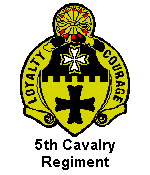
1st Bn, 5th Cavalry Reg't
 "HHC", 1st Bn, 5th
"HHC", 1st Bn, 5th
 Scout Pltn
Scout Pltn
 Mortar Pltn
Mortar Pltn
 "A" & "B" Cos (Mech)
"A" & "B" Cos (Mech)
 "C" & "D" Cos (Armor)
"C" & "D" Cos (Armor)
 "F" Co, 15th Bde Spt Bn
"F" Co, 15th Bde Spt Bn |
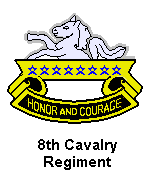
1st Bn, 8th Cavalry Reg't
 "HHC", 1st Bn, 8th
"HHC", 1st Bn, 8th
 Scout Pltn
Scout Pltn
 Mortar Pltn
Mortar Pltn
 "A", & "B" Cos (Mech)
"A", & "B" Cos (Mech)
 "C" & "D" Cos (Armor)
"C" & "D" Cos (Armor)
 "E" Co, 15th Bde Spt Bn
"E" Co, 15th Bde Spt Bn |
 |
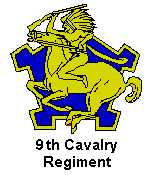
4th Sqdn, 9th Cavalry Reg't
 "HHT", 4th Sqdn, 9th
"HHT", 4th Sqdn, 9th
 Mortar Pltn
Mortar Pltn
 "A", "B" & "C" Trps
"A", "B" & "C" Trps
 "D" Co, 15th Bde Spt Bn
"D" Co, 15th Bde Spt Bn |
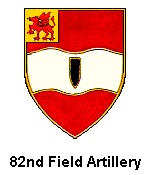
3rd Bn, 82nd Fld Arty
 "HHB", 3rd Bn, 82nd FA
"HHB", 3rd Bn, 82nd FA
 "A" & "B" Btry
"A" & "B" Btry
 "G" Co, 15th Bde Spt Bn
"G" Co, 15th Bde Spt Bn |
|---|
 |
|---|
|
|
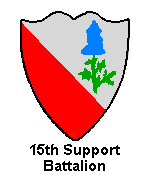
15th Bde Spt Bn (BSB)
 "HHC, 15th Bde Spt Bn
"HHC, 15th Bde Spt Bn
 "A", "B" & "C" Cos
"A", "B" & "C" Cos |
 |
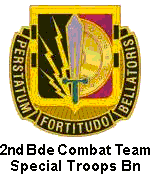
2nd Bde Spl Trps Bn (BSTB)
 "HHC", 2nd Bde Spl Trps
"HHC", 2nd Bde Spl Trps
 "A" Co, Military Intel
"A" Co, Military Intel
 UAV Platoon
UAV Platoon
 "B" Co, Signal
"B" Co, Signal
 "C" Co, Engineer
"C" Co, Engineer
 MP Platoon
MP Platoon
 NBC Recon Platoon
NBC Recon Platoon
|
|
|---|
|
|---|
| Date Of Issue - 04 July, 2011 |
|---|

 Today, the soldiers of the BLACK JACK Brigade Combat Team stand ready to
answer an on-order mission to reset, train, deploy, conduct combat operations
as directed, and redeploy while ensuring great care is provided for our
families.
Today, the soldiers of the BLACK JACK Brigade Combat Team stand ready to
answer an on-order mission to reset, train, deploy, conduct combat operations
as directed, and redeploy while ensuring great care is provided for our
families.
 The following folio of material highlights the many subsequent historical and
critical missions performed by members of the 1st Combat Brigade Team, whose
actions, operations and the many critical issues resolved over its 94 year
history to meet the changing threat and the honors they achieved are
summarized in the following sections:
The following folio of material highlights the many subsequent historical and
critical missions performed by members of the 1st Combat Brigade Team, whose
actions, operations and the many critical issues resolved over its 94 year
history to meet the changing threat and the honors they achieved are
summarized in the following sections:
 Table of Contents
Table of Contents
















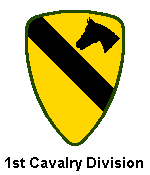



 If none of the data that you have found by surfing the reference unit chapter
titles and indexes measures up to your interests, you may want to deploy the
R&S (Reconnaissance and Surveillance) Scouts to search and identify keywords
or subjects within individual unit pages. Enter the descriptive keyword or
search terms(s) in the input field and "Click" on the Search button to screen the multiple DataBases of
the Cavalry OutPost and the garrisoned occupants - "The 1st Cavalry Division
and its Subordinate Units".
If none of the data that you have found by surfing the reference unit chapter
titles and indexes measures up to your interests, you may want to deploy the
R&S (Reconnaissance and Surveillance) Scouts to search and identify keywords
or subjects within individual unit pages. Enter the descriptive keyword or
search terms(s) in the input field and "Click" on the Search button to screen the multiple DataBases of
the Cavalry OutPost and the garrisoned occupants - "The 1st Cavalry Division
and its Subordinate Units".
 The search action will open the "first-team.us WebSite - R&S Scout Report",
which displays a listing of WebSite Titles and HTML Summaries that contain the
specific search term(s) of interest. To review any that best depicts a match
of your search term(s), "Click" on the WebSite Title to open a New Window.
After the WebSite is fully loaded, use the browser [EDIT/Find] Tool Button to
locate the search term within the page. After reviewing, close the New Window
to return to the listing of WebSites.
The search action will open the "first-team.us WebSite - R&S Scout Report",
which displays a listing of WebSite Titles and HTML Summaries that contain the
specific search term(s) of interest. To review any that best depicts a match
of your search term(s), "Click" on the WebSite Title to open a New Window.
After the WebSite is fully loaded, use the browser [EDIT/Find] Tool Button to
locate the search term within the page. After reviewing, close the New Window
to return to the listing of WebSites.




 If this is your first review of the Outpost of the 1st Cavalry Division and
its Subordinate Units, you may want to record your own report on your findings
during your visit, or perhaps you may want to review the log entries of other
visitors.
If this is your first review of the Outpost of the 1st Cavalry Division and
its Subordinate Units, you may want to record your own report on your findings
during your visit, or perhaps you may want to review the log entries of other
visitors.

To report on your findings,
"click" on the "Report-In"
Index Tab of the Troop Log. |
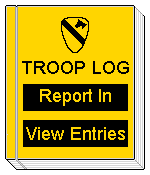
|

To review entries of others,
"Click"on the "View Entries"
Index Tab of the Troop Log. |
|---|

 As you journey through the history of the 1st Cavalry Division and its
assigned elements, you may find it interesting enough to send a message to
your friends and extend them an invitation for the opportunity to review the
rich history of the Division. We have made it easy for you to do. All that is
required is for you to click on the Push Button below, fill in their eMail
addresses and send.
As you journey through the history of the 1st Cavalry Division and its
assigned elements, you may find it interesting enough to send a message to
your friends and extend them an invitation for the opportunity to review the
rich history of the Division. We have made it easy for you to do. All that is
required is for you to click on the Push Button below, fill in their eMail
addresses and send.


|
The TITLE and URL of this WebSite are automatically read, formatted
and entered into your standard eMail form. |
|
|
Note - The eMail Message is processed and transmitted On-Line to the
addressee(s) via your Internet Provider.
Copyright © 2002, Cavalry Outpost Publications ® |




 eMail Your WebSite Comments.
eMail Your WebSite Comments.


 Return to "MyOwnPages"©.
Return to "MyOwnPages"©.

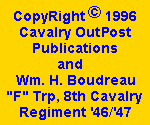 Copyright © 1996, Cavalry Outpost Publications ® and
Trooper Wm. H. Boudreau, "F" Troop, 8th Cavalry Regiment (1946 - 1947). All
rights to this body of work are reserved and are not in the public domain, or
as noted in the bibliography. Reproduction, or transfer by electronic means,
of the History of the 1st Cavalry Division, the subordinate units or any
internal element, is not permitted without prior authorization. Readers are
encouraged to link to any of the pages of this Web site, provided that proper
acknowledgment attributing to the source of the data is made. The information
or content of the material contained herein is subject to change without
notice.
Copyright © 1996, Cavalry Outpost Publications ® and
Trooper Wm. H. Boudreau, "F" Troop, 8th Cavalry Regiment (1946 - 1947). All
rights to this body of work are reserved and are not in the public domain, or
as noted in the bibliography. Reproduction, or transfer by electronic means,
of the History of the 1st Cavalry Division, the subordinate units or any
internal element, is not permitted without prior authorization. Readers are
encouraged to link to any of the pages of this Web site, provided that proper
acknowledgment attributing to the source of the data is made. The information
or content of the material contained herein is subject to change without
notice.
Revised 12 Jan '13 SpellChecked






 Introduction
Introduction





















 Copyright © 1996
Copyright © 1996